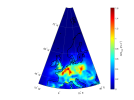Dear There,
I have successfully run the FHIST compset on my machine. Now I want to add a heat source to the model atmosphere at specific levels.
I consider two situations:
2D case: add regional heating (as shown in the figure) near the top of the planetary boundary layer (PBL)
3D case: add heating having the same horizontal distribution as in the 2D case, while decreasing exponentially with height

The regional heating data are monthly means and are only available for June/July/August from 2018 to 2021 (i.e. 12 months in total)
Although I have only regional data, I run the global model.
How to do these experiments?
My general idea is to expand the regional data to global first, then interpolate the data to match the model grid and then tell the model where to read the data. But I'm not even sure if this variable (i.e. heating rate) can be used by the model.
I know that, in principle, the 2D case can be done the same way as the 3D case (embedding the 2D data array into a global 3D array), but maybe there are simpler ways to perform the 2D experiment that I'm not aware of.
Thank you in advace!
I have successfully run the FHIST compset on my machine. Now I want to add a heat source to the model atmosphere at specific levels.
I consider two situations:
2D case: add regional heating (as shown in the figure) near the top of the planetary boundary layer (PBL)
3D case: add heating having the same horizontal distribution as in the 2D case, while decreasing exponentially with height

The regional heating data are monthly means and are only available for June/July/August from 2018 to 2021 (i.e. 12 months in total)
Although I have only regional data, I run the global model.
How to do these experiments?
My general idea is to expand the regional data to global first, then interpolate the data to match the model grid and then tell the model where to read the data. But I'm not even sure if this variable (i.e. heating rate) can be used by the model.
I know that, in principle, the 2D case can be done the same way as the 3D case (embedding the 2D data array into a global 3D array), but maybe there are simpler ways to perform the 2D experiment that I'm not aware of.
Thank you in advace!
